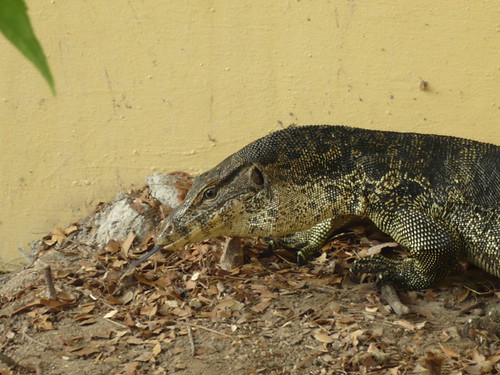
Malayan water monitor (Varanus salvator), Sungei Buloh Wetland Reserve;
The emblem I have chosen for this blog, and in a sense my totem creature, is the Malayan water monitor (Varanus salvator). Singapore's largest lizard, and in fact one of the largest lizards in the world for that matter, the Malayan water monitor has proven itself to be a skilled survivor and opportunist, capable of living in all sorts of environments. From mangrove swamps to sandy beaches, gardens and monsoon drains, even on distant offshore islands, as long as there is water nearby and sufficient vegetation to hide in, Malayan water monitors are more than capable of thriving. And in places where they are free from persecution, these lizards can become surprisingly tame around humans.
In a Singapore that has lost most of her megafauna species, this is a species that really stands out as a symbol for the resilience of much of our remaining native wildlife, which possess the ability to not just survive, but even thrive in the midst of our urban landscapes, as long as we are able to provide them with a few basic needs. It is a large, imposing, even majestic creature, and while reptiles may have few fans compared to birds or mammals, there is a certain beauty in watching a Malayan water monitor basking in the sun, lazily swimming, or foraging along the shore.
And yet, despite being so large and so common, the Malayan water monitor, like much of our wildlife, has become the subject of much ignorance, misunderstanding, and unwarranted revulsion. One of the biggest areas of irritation for me has been the fact that so many people just cannot get its name right.
NOT an Iguana
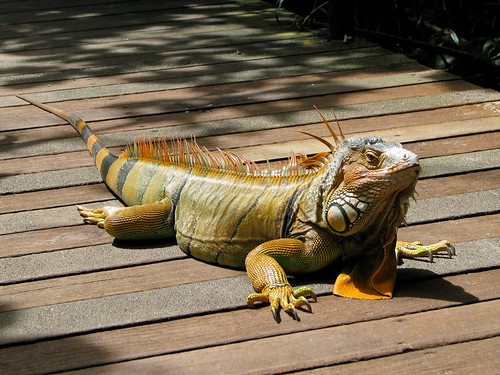
Green iguana, Singapore Zoo;
(Photo by Agnieszka)
For some reason, many people choose to call this lizard "iguana". The Iguanidae, for one thing, is not native to Singapore; they are exclusive to the Americas, islands of the Caribbean, the Galapagos Islands in the eastern Pacific, and Fiji. A common representative of the family that most people would have been exposed to at least once before is the green iguana (Iguana iguana), pictured above.
As you can see, the green iguana is a very different creature from the Malayan water monitor, and there really is no excuse mistaking one for the other.
NOT a crocodile

Estuarine crocodile, Sungei Buloh Wetland Reserve;
(Photo by Schristia)
Another common error that pops out whenever a Malayan water monitor is spotted includes mistaking the lizard for a crocodile. I will never forget the person on STOMP who took several good photos of a Malayan water monitor at East Coast Park (on land!) and called it a 'baby crocodile', to much wailing and gnashing of teeth from nature enthusiasts.
Sometimes, a monitor lizard in the water can look a little like a crocodile, but it does not take an expert to tell the two apart. Among the most obvious distinguishing features that differentiate the lizard from the crocodile are the shape of the head, and the fact that the monitor lizard lacks the bony scutes which adorn the crocodile's back, neck and tail. Besides, given the relative abundance of the Malayan water monitor, in comparison to the estuarine crocodile, which is still a rare element of our aquatic fauna, it is likely that any sightings of large aquatic reptiles are more likely to be of Varanus salvator than of Crocodylus porosus.
NOT a Komodo dragon
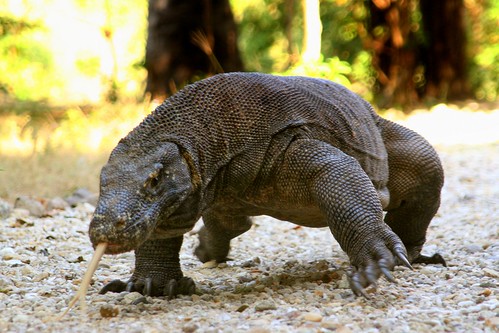
Komodo dragon, Komodo Island;
(Photo by chillntravel)
Another common misidentification is Komodo dragon, which can be somewhat forgivable, considering that Varanus komodoensis is the largest extant representative of the monitor lizard family. Of course, this is disregarding the fact that the species has a very limited range among several scattered islands in Indonesia, and that the only Komodo dragons to be found in Singapore are in captivity.
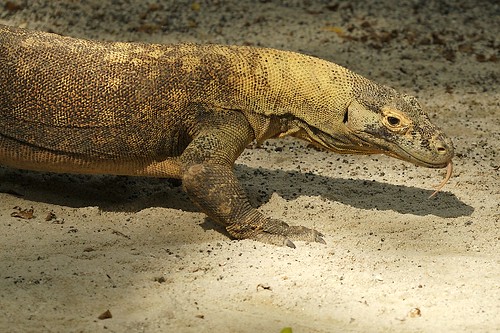
Komodo dragon, Singapore Zoo;
(Photo by robferblue)
NOT a dinosaur
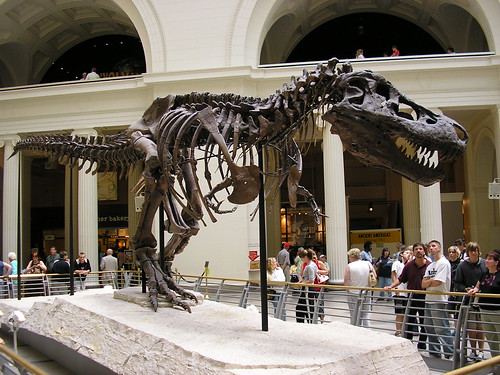
"Sue" the Tyrannosaurus, Chicago Field Museum;
(Photo by danh5150)
But the one erroneous name that really makes me roll my eyes is "dinosaur". I have heard it used mostly in jest, although I still retain the urge to throttle the chap who wrote about Tyrannosaurus rex swimming around in Sungei Buloh, as recounted to me by Siva. And it was a Life Sciences student!
Suffice to say that monitor lizards are certainly not living dinosaurs; they definitely lack the unique anatomical features that set the dinosaurs apart from all other groups of reptiles, extant or extinct. And while dinosaurs have actually survived to the present day, the only living representatives belong to that single highly specialised lineage we call birds.
NOT THAT DANGEROUS
Besides a long list of erroneous and completely wrong names, there is also an amazing amount of inaccurate information about the Malayan water monitor. There are quite a number of people who appear to overestimate the danger that it poses to humans. While there is no doubt that the Malayan water monitor's larger cousin the Komodo dragon has proven itself more than capable of incorporating human flesh into its diet, the Malayan water monitor lacks such inclinations, and would rather flee when approached. It is amazing how even the largest individuals, close to 2 metres in length, move with such speed in heading for the nearest clump of vegetation or rushing straight into the water when a person comes too close for comfort.
Not that they are complete pushovers; monitor lizards are more than capable of defending themselves when cornered, with their wickedly sharp claws, whiplike tail, and a mouth full of sharp teeth. But to date, I have seen this happen only once, with a juvenile on Pulau Sekudu which had been trapped in a net, and was struggling and resisting our efforts to free it.
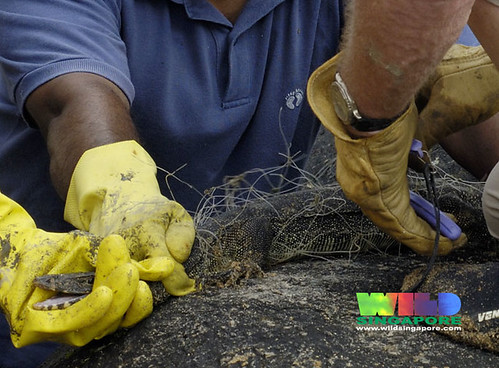
Juvenile Malayan water monitor, Pulau Sekudu
(Photo by Ria)
Another common misconception is that the monitor lizard has a fatal bite. This of course, is bunk. On one hand, recent research has indicated that monitor lizards do actually possess venom glands, although only a small number of species have been examined so far (mostly Australian species). It is very likely that the Malayan water monitor also has venom, although given that such venom appears to be used primarily for prey capture rather than for defence, it's doubtful that it's potent enough to be life-threatening to healthy human beings. So while it is definitely recommended that you seek medical attention in the rare event that you get bitten by a monitor lizard, it isn't exactly a serious medical emergency on par with say, getting bitten by a banded krait or king cobra.
Symbol of the ignorance which threatens our wilderness

Malayan water monitor, Sungei Buloh Wetland Reserve;
(Photo by Marcus)
In essence, the Malayan water monitor, and the great deal of misinformation about it, nicely encapsulate much of what ails nature in Singapore: a lack of awareness, and a lack of understanding.
The fact that so many Singaporeans are unable to correctly identify such a distinctive member of our remaining charismatic fauna shows a general lack of awareness about its identity. Labels like "iguana" or "Komodo dragon", used for lizard species not found in Singapore, indicate how many people are more aware of exotic species living in remote and distant places, rather than native species in urban Singapore itself. Exaggerating the risk to people can be a sign of how so many urbanites have become increasingly distant from nature, to the point that any perceived risks are overstated and amplified; targets of such fear-mongering are often non-human animals, which in some quarters are regarded with fear and intolerance. Inaccurate information about its "lethal venom" in turn reflect an apathy towards finding out accurate information about the true nature of the beast, instead taking outdated folklore and inaccurate second-hand information to be the gospel truth.
Of course, the Malayan water monitors couldn't give a damn about what we think or say about them; they just go about their business, hunting and scavenging at the water's edge. All they ask for is ample habitat, and that we leave them alone. Perhaps, the same can be said for much of our wilderness and wildlife. Give them space, and the right conditions, and they will thrive without intervention from us.